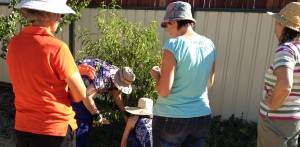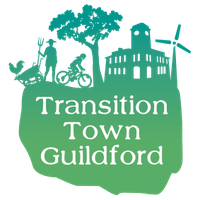
The mature Illawarra flame tree and Rose gum in Claymore Close park.
On Wednesday night (16th April), the City of Swan council voted (8 councillors to 6) to uphold a previous decision to chop down two mature, healthy trees on public land and not allow consultation with the broader community. The following tale would seem hard to believe, but it happened and is a ridiculous example of poor processes and decision making by City of Swan Councillors.
Firstly the background and history
1) On 22nd January, a petition by 11 local residents was presented to Council to remove the two trees on Claymore Close Park, the larger Rose Gum (Eucalyptus grandis) and smaller Illawarra Flame (Brachychiton acerifolia).
“The reasons put forward by the petitioners for the removal of the trees were the mess in the park made by the shedding bark and small branches from the tree, the risk of large branches excising from the tree, and the risk associated with the falling of the tree during storm and wind events.” – City of Swan
City officers visited the site and found the debris to be “normal
seasonal habits of this species of tree”, but in addition an expert Arborist was consulted and a report prepared –
“The report identified that the trees were healthy and in sound condition with no remedial works required. The risk assessment confirmed that the trees represent a low risk to the public.” – City of Swan, my emphasis.
Therefore at the Council meeting on 5th March, Council staff recommended that the two trees remain, but “If Council resolves to remove the trees, it is recommended that such removal be subject to consultation with the community.“
The councillors present voted unanimously to retain the trees (14-0). So far so good, a logical, evidence based result. All the above can be read in the council recommendation and arborists report.
2) Three weeks later at the next council meeting Midland/Guildford ward Councillor Daniel Parasiliti, who was absent on family matters from the last meeting, moved a new motion to remove the trees. Stating that:
“Record the reason for the motion is that it is not accepted that the trees (subject of this petition) are of ‘low risk’ and it is believed that they pose an unsatisfactory risk to local residents.”
This is when a major flaw in the accessibility and accountability of council meetings becomes evident. Nothing is recorded of the debate, statements or arguments made in the Council minutes. Only the motion, outcome (9-5) and those who voted for chopping the trees (Crs Cheung, Elliott, Gregorini, Haynes, McNamara, Parasiliti, Trease, Williams and Zannino) and those against (Crs Bailey, Congerton, Lucas, McDonnell and Wainwright).
The only reason I had any idea about this was a friend happened to be there and mentioned some of the false and illogical arguments made by Cr Parasiliti, for example, ‘neither the residents group, the Guildford Association, or Transition Town Guildford had opposed the motion, so clearly they support cutting down the trees’. What!?
What happens if you have no idea such a motion is being moved? Presumably ratepayer, community groups and even broader residents should be informed of relevant motions or consulted? Why was the original staff recommendation (above), to go to a community consultation if the trees are to be removed, not enacted?
Or what happens if you happen to have a clash with another meeting that night? Surely in this age of technology the council could record audio of all proceedings of meetings and provide them online for residents who were absent or have accessibility issues in getting to meetings. This would allow all residents in such a large and diverse City to hear what is said by their representatives. I understand the South Perth council and some other metro councils already do this.
Nonetheless, I gather that Cr Parasiliti and Cr Gregorini argued, contrary to their own staff and expert evidence of arborist, that the report was flawed (branches were found on the ground which were 5 cm and not 3.5 cm, and the tree was not viewed on a windy day), and therefore poses an “unsatisfactory risk to local residents”. How a unanimous vote by council can change next meeting to a 9-5 defeat is perplexing to say the least. Did the trees suddenly become more dangerous three weeks later?
Other questions this raises are:
- Was the consultant given a chance to rebut the statements made by Councillors regarding the report?
- If the report is actually flawed, why did the council pay for it in the first place? And will they be seeking reimbursement?
This decision also sets a dangerous precedent. Without a pressing need or demonstrated risk, can residents simply lobby to have public trees removed?
The final chapter
3) For the next meeting Cr Bailey moved a motion to rescind the previous decision to chop down the trees, with the intention of allowing community consultation on the matter. I gave a deputation on the issue on behalf of Transition Town Guildford, which is pasted below.
Unfortunately, the council voted against the motion (6-8): For, Crs Bailey, Congerton, Färdig, Lucas, McDonnell and Wainwright. Those against allowing community consultation Crs Elliott, Gregorini, Haynes, McNamara, Parasiliti, Trease, Williams and Zannino.
It was extremely disappointing that all three of our local Midland/Guildford Councillors (listed below) voted against this motion. Not only to chop down mature, healthy public trees, but to not even allow a stay of execution for community consultation.
Personally, it was also disturbing to hear the arguments being made in favour of cutting down public trees by those against the motion. Paraphrased as:
- The Gum tree is out of place, it’s too high and wide for a small park (Cr Gregorini)
- Gum trees drop limbs, I don’t trust them (Cr Haynes)
- Exchange of trees makes up for it (Cr Elliott)
- Local residents should decide, it’s in a cul de sac not Stirling Square (Cr Parasiliti)
- There’s no new evidence or petition to refute assertion of a flawed report/high risk (Cr Parasiliti)
- What’s more valuable, a tree or a life? (Cr McNamara)
Other Councillors did address some of these arguments, but it’s frustrating that members of the public aren’t able to address these in the debate. Here are some quick rebuttals:
- This is Australia, Gum trees are our native flora and Rose Gums are one of the original historic trees of Guildford.
- The tree is in the middle of a park and not over hanging private property. Benefits of trees increase with size, so the bigger the better I say.
- Yes, Gum trees drop limbs, but some species are more prone than others. And if an expert says the tree is healthy and low risk what more can you do.
- Mature trees which are potentially 50 years old cannot simply be ‘replaced’ by planting a new sapling. It will take decades for the same result. [Update – I’ve since been informed by a resident that the Gum tree is around 11-12 years old]
- It doesn’t matter if it’s in a small park in a cul de sac or a large park, public trees are the property of all residents of the city, and in my view the Councillors are entrusted with preserving our natural heritage.
- No expert evidence was ever provided to show a flaw in the report or high risk to residents. Do residents have to sign petitions and hold protests on every decision to demonstrate that we don’t support it?
- We live in a world with risks, we can’t cut down all the trees and wrap ourselves in cotton wool.
Finally, to add insult to injury it became clear during the debate that the local residents had not viewed the Flame tree as a risk and a majority of Councillors accepted it could remain. However, they were unwilling to vote to rescind the motion and no other avenue was available to modify the previous decision to save it. Again, I think this highlights a flaw in the decision making process.
The sad part is, this never should have got to this stage. The first decision by council should have been an opportunity for staff and Councillors to explain to local residents that the tree was safe and the numerous benefits they provide to our community, which I outline below.
I encourage everyone to go immediately and view these trees in Claymore Close (behind the Woodbridge tavern) before they are removed. Feel free to tie a ribbon or leave a memento to commemorate this senseless destruction.
I also encourage you to contact the Midland/Guildford ward councillors and let them know what you think about this decision. You might like to CC the Mayor (who also voted for the chop), Deputy Mayor and CEO, details below or find your local Councillor here.
Cr Daniel Parasiliti: daniel.parasiliti@swan.wa.gov.au, 0403 241 821
Cr Sandra Gregorini: sgregorini@globaldial.com, 9294 1827
Cr Mark Elliott: mark_d_elliott@live.com, 0458 660 804
Mayor Charlie Zaninno: charlie.zannino@swan.wa.gov.au, 9267 9104
Deputy Mayor Mick Wainwright: mick.wainwright@swan.wa.gov.au, 9377 7845
CEO Mike Foley: mike.foley@swan.wa.gov.au
My deputation:
Good evening Mayor, Deputy Mayor, Councillors and staff.
I’d like to address the issue of the trees in Claymore Close, but also the broader benefits of well-established trees to the city and community.
Let me make it clear that I and the committee of Transition Town Guildford do not support the removal of these trees. They are young, healthy, in the middle of a public park, and do not overhang any property.
One of the key issues raised is risk. We must acknowledge that there are inherent risks in every part of our lives, and that we cannot control everything in our environment. In this case, we should listen to the experts, the Arborists report, as the council did originally. It clearly states there is low risk. To argue otherwise must be demonstrated and supported by evidence, not emotions.
But also to realise that every tree has risks. The Jacaranda trees already present and proposed as replacements drop copious amounts of flowers, which attract bees. You may be familiar, as I was as a child, the often occurrence of stepping on a bee in bare feet under a Jacaranda. So does the risk of bee stings and anaphylaxis require that we remove the Jacaranda’s as well? Removing these trees when there is low risk sets a dangerous precedent.
As an example, down south next to the medical centre where my father holds a clinic there was a massive native Christmas tree (Nutysia Floribunda). You will be familiar with the glorious bright yellow masses of flowers this parasitic plant produces around Christmas time. This was the largest specimen I’ve ever seen, most likely over 100 years old. It was located in front of a day care centre, which for years had operated without incident. However, the day care centre was then bought by ABC learning, which required that the tree be removed, in case a child was stung and died from a reaction. Even though located next door to a medical centre, the tree was removed. But < 6 months later, ABC went bust, the child care centre changed hands again, minus the glorious and unique tree.
My point is, Council has a responsibility to protect trees as a public good. Businesses and residents change hands, and people come and go, but these trees, with care, will be there long after all of us. Of course residents of a street should have input to their surrounds. But the council must weigh this against the protection of trees for the community as a whole, for future residents and future generations, along with the numerous benefits trees provide, which I’ll now briefly mention.
Trees are vital for alleviating ‘the urban heat island effect’. We know that heat waves are the biggest natural killer in Australia. For example, twice as many people were killed in the heat wave before the tragic Victorian Black Saturday bush fires as were killed in the fires themselves.
Studies have shown that suburbs with trees are 4-6 C degrees cooler than non-treed suburbs – thanks to shade and transpiration. And the bigger the tree the greater the benefit. Removing these trees in their prime will mean > 20 years before a similar benefit is received by any replacement. With increasing climate change and extreme heat waves, having leafy suburbs will literally make the difference between life and death for the most vulnerable.
This is exactly why the City of Vincent has set a target to double the amount of shade from trees by 2050, and will spend $200 000 on it this year alone!
There are also numerous benefits financially. Shade from trees prolongs the life of bitumen by protecting it from harsh summer conditions. And a study by the University of Western Australia last year found that properties on tree lined streets were worth an extra $16 000.
And of course trees provide a myriad of other benefits, including cleaning air pollution, storm flood mitigation, and for native trees in particular, like this Eucalypt, provide habitat for birds and biodiversity. Trees even provide benefits for mental health, with numerous studies showing positive effects on productivity, recovery and well-being when people see vegetation.
Finally, I’d like to correct comments made about Transition Town Guildford during the debate last meeting on this issue. It was flattering to hear that Guildford residents are the most politically active, however, this doesn’t mean we pore over Council Agenda’s and Minutes as claimed. We probably should. But we’re busy people, doing stuff in our community, and with commitments that often clash with council meetings. It’s false logic to assert that just because we aren’t vocal and loud on an issue, we approve. Lack of opposition is not evidence of support.
In conclusion, I hope that you will support Cr Bailey’s motion later in the meeting and preserve these trees. I hope that the original decision, based on sound expert evidence will prevail.
Thank you.








